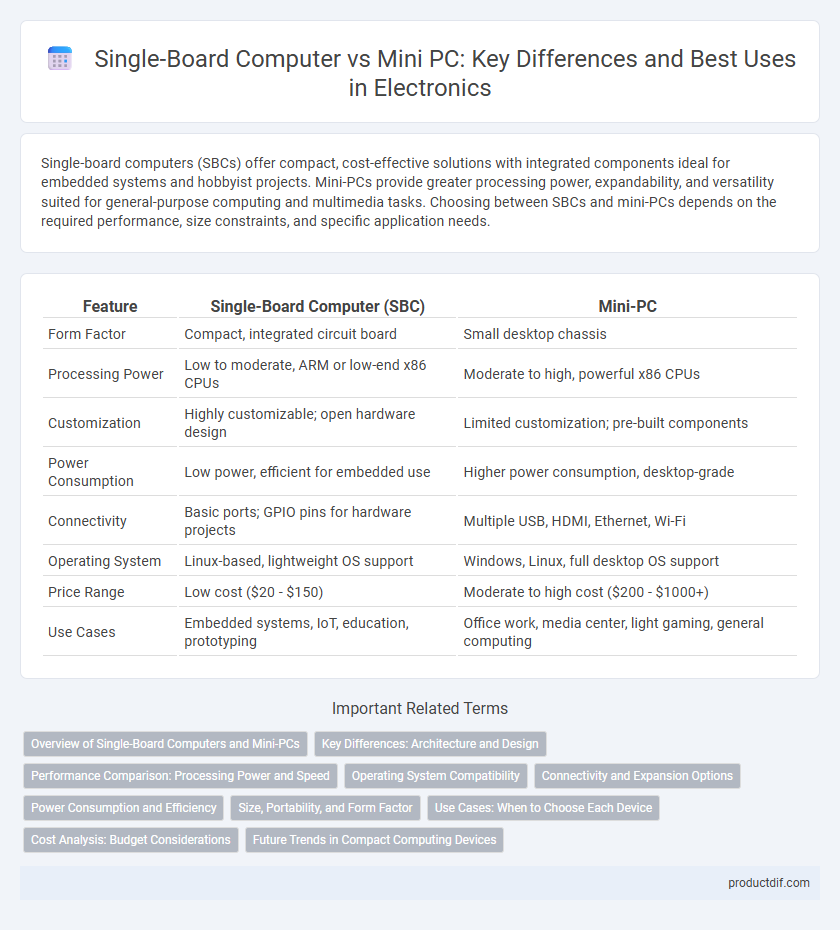Single-board computers (SBCs) offer compact, cost-effective solutions with integrated components ideal for embedded systems and hobbyist projects. Mini-PCs provide greater processing power, expandability, and versatility suited for general-purpose computing and multimedia tasks. Choosing between SBCs and mini-PCs depends on the required performance, size constraints, and specific application needs.
Table of Comparison
| Feature | Single-Board Computer (SBC) | Mini-PC |
|---|---|---|
| Form Factor | Compact, integrated circuit board | Small desktop chassis |
| Processing Power | Low to moderate, ARM or low-end x86 CPUs | Moderate to high, powerful x86 CPUs |
| Customization | Highly customizable; open hardware design | Limited customization; pre-built components |
| Power Consumption | Low power, efficient for embedded use | Higher power consumption, desktop-grade |
| Connectivity | Basic ports; GPIO pins for hardware projects | Multiple USB, HDMI, Ethernet, Wi-Fi |
| Operating System | Linux-based, lightweight OS support | Windows, Linux, full desktop OS support |
| Price Range | Low cost ($20 - $150) | Moderate to high cost ($200 - $1000+) |
| Use Cases | Embedded systems, IoT, education, prototyping | Office work, media center, light gaming, general computing |
Overview of Single-Board Computers and Mini-PCs
Single-board computers (SBCs) integrate a microprocessor, memory, and input/output interfaces on a single circuit board, often used in embedded systems, DIY projects, and edge computing due to their compact size and low power consumption. Mini-PCs provide a complete desktop computing experience in a small form factor with more powerful processors, expandable storage, and multiple connectivity options suited for office work, media centers, and light gaming. Choosing between SBCs and Mini-PCs depends on processing power requirements, flexibility, and intended application scenarios.
Key Differences: Architecture and Design
Single-board computers (SBCs) feature integrated components on a single circuit board, offering compact architecture ideal for embedded systems and IoT applications. Mini-PCs possess modular designs with separate components such as CPU, RAM, and storage, enabling higher performance and expandability for general-purpose computing. The architectural distinction impacts power consumption, thermal management, and customization possibilities, with SBCs prioritizing minimalism and efficiency while mini-PCs focus on versatility and upgradability.
Performance Comparison: Processing Power and Speed
Single-board computers (SBCs) typically feature lower processing power with ARM-based processors optimized for energy efficiency, making them suitable for lightweight tasks and embedded applications. Mini-PCs usually incorporate more powerful x86 processors from Intel or AMD, offering higher clock speeds, multiple cores, and superior multitasking capabilities, which enhance performance for demanding applications like gaming, video editing, and software development. Benchmark tests reveal mini-PCs outperform SBCs significantly in CPU-intensive operations, reflecting their advantage in processing speed and overall computational power.
Operating System Compatibility
Single-Board Computers (SBCs) such as Raspberry Pi primarily support lightweight, open-source operating systems like Linux distributions (Raspbian, Ubuntu) and some versions of Windows IoT Core. Mini-PCs offer broader OS compatibility including full versions of Windows, macOS (on select models), and various Linux distributions, enabling more complex applications and enterprise use. The choice between SBC and Mini-PC depends heavily on the required software ecosystem and specific operating system support for the target electronic project.
Connectivity and Expansion Options
Single-board computers (SBCs) typically offer limited connectivity and expansion options, often featuring essential ports like USB, HDMI, and GPIO pins for hardware interfacing, making them ideal for compact, dedicated projects. Mini-PCs provide a broader range of connectivity with multiple USB ports, Ethernet, Wi-Fi, and sometimes Bluetooth, alongside support for internal expansions such as additional storage drives and PCIe cards. The choice between an SBC and a mini-PC depends on the need for flexibility in peripheral support and hardware scalability within the electronics project.
Power Consumption and Efficiency
Single-board computers (SBCs) typically consume between 5 to 15 watts, making them highly efficient for low-power applications and embedded systems. Mini-PCs, however, often draw 20 to 60 watts due to more powerful processors and expanded hardware capabilities, trading off energy efficiency for performance. Choosing between SBCs and mini-PCs hinges on balancing power consumption requirements with computational demands in electronics projects.
Size, Portability, and Form Factor
Single-board computers (SBCs) are compact, integrated circuits with essential components on a single board, offering unmatched portability and small form factors ideal for embedded applications and DIY projects. Mini-PCs, although larger than SBCs, provide more powerful hardware configurations and multiple expansion ports while maintaining a relatively small footprint compared to traditional desktops. The choice between SBCs and mini-PCs depends on the balance between space constraints, computing power requirements, and connectivity options.
Use Cases: When to Choose Each Device
Single-board computers (SBCs) excel in embedded systems, IoT projects, and educational purposes due to their compact size, low power consumption, and affordability. Mini-PCs are ideal for home entertainment, office productivity, and light gaming, offering higher processing power, expandability, and better connectivity options. Choose SBCs for cost-effective, space-constrained applications requiring customization, while Mini-PCs fit scenarios demanding more robust performance and versatile user interfaces.
Cost Analysis: Budget Considerations
Single-board computers (SBCs) typically offer a lower initial cost, making them ideal for projects with strict budget constraints and basic computing needs. Mini-PCs, while generally more expensive upfront, provide enhanced performance, greater storage capacity, and better expandability, which can reduce long-term costs in professional or multimedia applications. Evaluating total cost of ownership including power consumption, upgradability, and software compatibility is crucial when choosing between SBCs and mini-PCs for cost-effective electronics solutions.
Future Trends in Compact Computing Devices
Future trends in compact computing devices highlight increasing integration of AI accelerators and advanced connectivity options in single-board computers (SBCs), enhancing their capabilities for edge computing and IoT applications. Mini-PCs are evolving with more powerful CPUs, improved thermal management, and versatile form factors to support diverse workloads in home and office environments. Both SBCs and mini-PCs leverage advancements in low power consumption and modular architectures, driving innovation in portable and embedded systems.
Single-Board Computer vs Mini-PC Infographic

 productdif.com
productdif.com